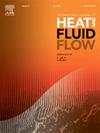Switching between supercritical and subcritical turbulent transitions in inner cylinder rotating Taylor–Couette–Poiseuille flow
IF 2.6
3区 工程技术
Q2 ENGINEERING, MECHANICAL
International Journal of Heat and Fluid Flow
Pub Date : 2024-12-06
DOI:10.1016/j.ijheatfluidflow.2024.109667
引用次数: 0
Abstract
The Taylor–Couette flow between a stationary outer cylinder and rotating inner cylinder undergoes a supercritical transition. After becoming linearly unstable, the flow becomes progressively more complex: as the inner cylinder rotation Reynolds number increases, the flow state changes to the Taylor vortex flow (TVF) wavy Taylor vortex flow (WVF) modulated wavy Taylor vortex flow (MWV). In contrast, annular Poiseuille flow, driven by an axial pressure gradient in concentric cylinders, undergoes a subcritical transition. Its subcritical turbulent flow features helical-shaped localized turbulence (HLT). The Taylor–Couette–Poiseuille flow, which is a combined shear flow of cylinder-rotation-driven flow and axial pressure-driven flow, is the subject of this study. We investigated the flow state transition processes for a high radius ratio of 0.883 at three different values, using direct numerical simulations. We demonstrated that in the TVF and WVF-based cases, the pressure-driven axial flow stabilized into the Taylor-vortex-free flow field, with the WVF state transitioning to the TVF state before laminarization. A further increase in the axial pressure gradient led to intermittent turbulence, similar to HLT. These facts indicate that the switch from supercritical to subcritical transitions occurs across laminarization. In the MWV-based case, at a higher , the flow does not exhibit laminarization but becomes fully turbulent, unlike in the lower cases. However, the waviness of the Taylor vortex disappeared, and the pre-multiplied energy spectra confirmed partial stabilization before the transition to turbulence. From the perspective of Lumley’s anisotropic invariant map, the TVF- and WVF-based cases have one- or two-component anisotropy under all conditions. However, the MWV-based case becomes continuously similar to the anisotropic map of typical turbulent channel flow as increases.

求助全文
约1分钟内获得全文
求助全文
来源期刊

International Journal of Heat and Fluid Flow
工程技术-工程:机械
CiteScore
5.00
自引率
7.70%
发文量
131
审稿时长
33 days
期刊介绍:
The International Journal of Heat and Fluid Flow welcomes high-quality original contributions on experimental, computational, and physical aspects of convective heat transfer and fluid dynamics relevant to engineering or the environment, including multiphase and microscale flows.
Papers reporting the application of these disciplines to design and development, with emphasis on new technological fields, are also welcomed. Some of these new fields include microscale electronic and mechanical systems; medical and biological systems; and thermal and flow control in both the internal and external environment.
 求助内容:
求助内容: 应助结果提醒方式:
应助结果提醒方式:


